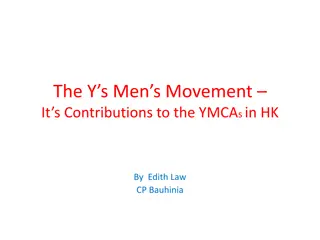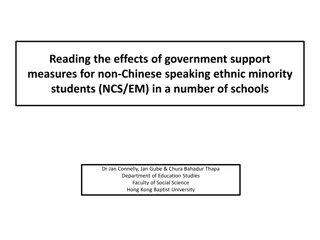
Understanding Behavioural and Psychological Symptoms in Vascular Dementia among Hong Kong Chinese
Explore the patterns of behavioural and psychological symptoms in vascular dementia among Hong Kong Chinese individuals through a study conducted by Dr. Cho Yiu Yung. The research focuses on 100 subjects diagnosed with vascular dementia according to NINDS-AIREN criteria, aiming to shed light on the manifestation of BPSD in this population.
Download Presentation

Please find below an Image/Link to download the presentation.
The content on the website is provided AS IS for your information and personal use only. It may not be sold, licensed, or shared on other websites without obtaining consent from the author. If you encounter any issues during the download, it is possible that the publisher has removed the file from their server.
You are allowed to download the files provided on this website for personal or commercial use, subject to the condition that they are used lawfully. All files are the property of their respective owners.
The content on the website is provided AS IS for your information and personal use only. It may not be sold, licensed, or shared on other websites without obtaining consent from the author.
E N D
Presentation Transcript
Behavioural and Psychological Symptoms in Vascular Dementia in Hong Kong Chinese Dr Cho Yiu YUNG FRCP (London, Edinburgh, Glasgow, Ireland) Head, Division of Geriatric Medicine Dept. of Medicine & Geriatrics United Christian Hospital Hong Kong
Objective To study the pattern of behavioural and psychological symptoms (BPSD) in vascular dementia amongst Hong Kong Chinese
Subjects 100 consecutive subjects attending a Memory Clinic, located in a district hospital in Hong Kong Diagnosed to have vascular dementia (in accordance with NINDS-AIREN criteria): Probable Possible
NINDS-AIREN Criteria The criteria for the clinical diagnosis of probablevascular dementia include all of the following: Dementia defined by cognitive decline from a previously higher level of functioning and manifested by impairment of memory and of two or more cognitive domains (orientation, attention, language, visuospatial functions, executive functions, motor control, and praxis), preferable established by clinical examination and documented by neuropsychological testing; deficits should be severe enough to interfere with activities of daily living not due to physical effects of stroke alone. Exclusion criteria: cases with disturbance of consciousness, delirium, psychosis, severe aphasia, or major sensorimotor impairment precluding neuropsychological testing. Also excluded are systemic disorders or other brain diseases (such as AD) that in and of themselves could account for deficits in memory and cognition. Cerebrovascular disease, defined by the presence of focal signs on neurologic examination, such as hemiparesis, lower facial weakness, Babinski sign, sensory deficit, hemianopia, and dysarthria consistent with stroke (with or without history of stroke), and evidence of of relevant CVD by brain imaging (CT or MRI) including multiple large vessel infarcts or a single strategically placed infarct (angular gyrus, thalamus, basal forebrain, or PCA or ACA territories), as well as multiple basal ganglia and white matter lacunes, or extensive periventricular white matter lesions, or combinations thereof. A relationship between the above two disorders, manifested or inferred by the presence of one or more of the following: (a) onset of dementia within 3 months following a recognized stroke; (b) abrupt deterioration in cognitive functions; or fluctuating, stepwise progression of cognitive deficits
NINDS-AIREN Criteria Clinical diagnosis of possible vascular dementia may be made: in the presence of dementia with focal neurologic signs in patients in whom brain imaging studies to confirm definite CVD are missing; or in the absence of clear temporal relationship between dementia and stroke; or in patients with subtle onset and variable course (plateau or improvement) of cognitive deficits and evidence of relevant CVD.
Assessment Patient subjective experiences Collateral clinical history: objective behaviour Neuropsychiatric Inventory (NPI) Global Deterioration Scale (GDS)
NPI Tool for assessing changes in behavioral and psychological disturbances Also evaluates impact of behavior on caregivers Numeric scale: 1 144 <20: Mild 20 50: Moderate >50 : Severe Can be used to monitor treatment efficacy
NPI: 12 domains Irritability Delusions (paranoia) Euphoria Hallucinations Disinhibition Agitation / aggression Aberrant motor behavior Dysphoria Nighttime behavior disturbance Anxiety Appetite/ eating abnormalities Apathy
Assessment Patient subjective experiences Collateral clinical history: objective behaviour Neuropsychiatric Inventory (NPI) Global Deterioration Scale (GDS)
GLOBAL DETERIORATION SCALE (GDS) Stage 1: No subjective complaints of memory deficit. No memory deficit evident on clinical interview. Stage 2: Subjective complaints of memory deficit, most frequently in following areas: (a) forgetting where one has placed familiar objects; (b) forgetting names one formerly knew well. No objective evidence of memory deficit on clinical interview. No objective deficit in employment or social situations. Appropriate concern with respect to symptomatology. Stage 3: Earliest clear-cut deficits. Manifestations in more than one of the following areas: (a) patient may have gotten lost when traveling to an unfamiliar location. (b) co-workers become aware of patient's relatively poor performance. (c) word and/or name finding deficit become evident to intimates. (d) patient may read a passage or book and retain relatively little material. (e) patient may demonstrate decreased facility remembering names upon introduction to new people. (f) patient may have lost or misplaced an object of value. (g) concentration deficit may be evident on clinical testing. Objective evidence of memory deficit obtained only with an intensive interview. Decreased performance in demanding employment and social settings. Denial begins to become manifest in patient. Mild to moderate anxiety frequently accompanies symptoms.
GLOBAL DETERIORATION SCALE (GDS) Stage 4. Clear-cut deficit on careful clinical interview. Deficit manifest in following areas: (a) decreased knowledge of current and recent events. (b) may exhibit some deficit in memory of one's personal history. (c) concentration deficit elicited on serial subtractions. (d) decreased ability to travel, handle finances, etc. Frequently no deficit in following areas: (a) orientation to time and place. (b) recognition of familiar persons and faces. (c) ability to travel to familiar locations. Inability to perform complex tasks. Denial is dominant defense mechanism. Flattening of affect and withdrawal from challenging situations. Stage 5. Patient can no longer survive without some assistance. Patient is unable during interview to recall a major relevant aspect of their current life, e.g.: (a) their address or telephone number of many years. (b) the names of close members of their family (such as grandchildren). (c) the name of the high school or college from which they graduated. Frequently some disorientation to time (date, day of the week, season, etc.) or to place. An educated person may have difficulty counting back from 40 by 4s or from 20 by 2s. Persons at this stage retain knowledge of many major facts regarding themselves and others. They invariably know their own names and generally know their spouse's and children's names. They require no assistance with toileting or eating, but may have difficulty choosing the proper clothing to wear.
GLOBAL DETERIORATION SCALE (GDS) Stage 6. May occasionally forget the name of the spouse upon whom they are entirely dependent for survival. Will be largely unaware of all recent events and experiences in their lives. Retain some knowledge of their surroundings; the year, the season, etc. May have difficulty counting by 1s from 10, both backward and sometimes forward. Will require some assistance with activities of daily living: (a) may become incontinent. (b) will require travel assistance but occasionally will be able to travel to familiar locations. Diurnal rhythm frequently disturbed. Almost always recall their own name. Frequently continue to be able to distinguish familiar from unfamiliar persons in their environment. Personality and emotional changes occur. These are quite variable and include: (a) delusional behavior, e.g., patients may accuse their spouse of being an imposter; may talk to imaginary figures in the environment, or to their own reflection in the mirror. (b) obsessive symptoms, e.g., person may continually repeat simple cleaning activities. (c) anxiety symptoms, agitation, and even previously non-existent violent behavior may occur. (d) cognitive abulia, e.g., loss of willpower because an individual cannot carry a thought long enough to determine a purposeful course of action. Stage 7. All verbal abilities are lost over the course of this stage. Early in this stage words and phrases are spoken but speech is very circumscribed. Later there is no serviceable speech at all - only unintelligible utterances with rare emergence of seemingly forgotten words and phrases. Incontinent; requires assistance toileting and feeding. Basic psychomotor skills (e.g. ability to walk) are lost with the progression of this stage. The brain appears to no longer be able to tell the body what to do. Generalized rigidity and developmental neurologic reflexes are frequently present
Results: Severity of Disease GDS Staging 4 5 62% 38%
Results: Incidence of BPSD GDS Staging 4 5 Incidence of BPSD 8% 91%
Results: Pattern of BPSD BPSD Delusion Hallucination Depression Apathy Anxiety Elation 20% 12% 42% 21% 16% 12% BPSD Disinhibition Aggression Irritability Aberrant Motor Sleep Disorders Eating Disorders 8% 11% 13% 11% 26% 19%
Conclusion BPSDs are frequent in vascular dementia of mild-to-moderate severity Like other types of dementia, correct identification and evaluation of BPSDs is a crucial component of clinical approach to vascular dementia
NINDS-AIREN Criteria Clinical features consistent with the diagnosis of probable vascular dementia include the following: Early presence of gait disturbance (small-step gait or marche a petits pas, or magnetic, apraxic-ataxic or parkinsonian gait) History of unsteadiness and frequent, unprovoked falls Early urinary frequency, urgency, and other urinary symptoms not explained by urologic disease Pseudobulbar palsy Personality and mood changes, abulia, depression, emotional incontinence, or other subcortical deficits including psychomotor retardation and abnormal executive function.
NINDS-AIREN Criteria Features that make the diagnosis of vascular dementia uncertain or unlikely include: Early onset of memory deficit and progressive worsening of memory deficit and progressive worsening of memory and other cognitive functions such as language (transcortical sensory aphasia), motor skills (apraxia), and perception (agnosia), in the absence of corresponding focal lesions on brain imaging Absence of focal neurological signs, other than cognitive disturbance Absence of cerebrovascular lesions on brain CT or MRI
NINDS-AIREN Criteria Criteria for diagnosis of definite vascular dementia are: clinical criteria for probable vascular dementia histopathologic evidence of CVD obtained from biopsy or autopsy absence of neurofibrillary tangles and neuritic plaques exceeding those expected for age absence of other clinical or pathological disorder capable of producing dementia Classification of vascular dementia for research purposes may be made on the basis of clinical, radiologic, and neuropathologic features, for subcategories or defined conditions such as cortical vascular dementia, subcortical vascular dementia, BD, and thalamic dementia.
NPI: Scoring Frequency X Severity Frequency 1: Occasionally (less than 1/week) 2: Often (about 1/week) 3: Frequently (several times/week, but < every day) 4: Very frequently (once or more/day)
NPI: Scoring Frequency X Severity Severity 1: Mild (noticeable, but not a significant change) 2: Moderate (significant, but not a dramatic change) 3: Severe (very marked, a dramatic change)






















